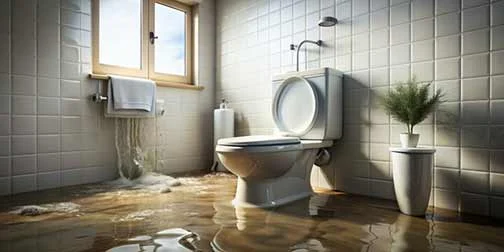
If there is a ranking for the different types of plumbing problems that can happen in your home, a sewer backup would certainly occupy the top spot, says TXC Realty Group. No other plumbing problem greatly threatens your health, personal belongings, and home than a backed-up sewer line.
A backed-up sewer line will contaminate your home with bacteria, leave your house smelling of sewage for weeks, cause extensive damage to your property, and almost empty your wallet. Even after the problem is fixed, you still have to deal with mold in your home.
However, this problem is entirely avoidable if you know its underlying causes and warning signs.
Potential causes of sewer backup in your Illinois homes
- Blockages: Sewer line blockages are the leading cause of sewer backups. These clogs are often caused by misuse of the sewer line by the home’s occupant.
- Tree root invasion: Tree roots can exploit weak joints and cracks to invade and block your sewer line, especially if the sewer line is made of aging clay and cast-iron pipes.
- Poor design and improper installation: A sewer line with improper sloping, inadequate venting, wrongly sized pipes, and substandard materials will be predisposed to backups from the outset.
- Misaligned pipes: Ground movements due to earthquakes, soil erosion, heavy rainfall, freezing temperatures, and other factors can cause your sewer line to sag or buckle.
- Heavy rainfall: Floodwaters can overwhelm municipal sewer lines, causing the wastewater inside the lines to flow backward into homes.
Signs that your sewer line is about to back up
- Sewage odors in your home
This happens when sewer gases enter your home because they cannot escape through the blocked sewer line.
- Slow drainage
One slow drain is not necessarily a sign of an impending sewer backup. But if several drains are slow at the same time, you may want to check your sewer line.
- Strange noises from the drains
A bubbling or gurgling noise from your toilet is a sign that the sewer line is blocked and gases are trapped in the pipes.
- Water backing up
If water is backing up into your shower, toilet, and floor drains, your home is on the verge of suffering a sewer backup.
- Multiple drain clogs
If several drains in your home are clogged or backed up simultaneously, there is a budding sewer back up in the works
How to fix a backed-up sewer line
Do these steps if your sewer line is backing up:
- Stop all water usage: The problem will only worsen if more water enters your drainage system. Turn off the water supply at the main water shutoff valve.
- Isolate the problem: Check your drains to identify the source of the problem. If possible, plug the affected drain to prevent more water from being dumped into your home.
- Remove your belongings: Remove all items that can be damaged by water from the area.
- Do not try a DIY: If the problem results from a backed-up sewer line, you can’t fix it with a plunger or drain cleaning bladder.
- Call an emergency plumber: Don’t just call any plumber; an emergency plumber will respond faster. This is critical for minimizing damage, disruption, and costs.
Steps to prevent a sewer backup in your Illinois home
The following long-term solutions will help you avoid a recurrence of the problem:
- Don’t pour fats, oils, and grease into your drains
FOG (fat, oil, and grease) will hurt your sewer line. Inside the sewer line, FOG becomes a hard, sticky substance that lines pipe walls and traps debris.
- Dispose of food waste properly
Do not dump coffee grounds, eggshells, fibrous vegetables, starchy foods (like pasta, rice, or mashed potatoes), and large food scraps into the drains.
- Install strainers on the drains
Installing a cover or strainer on sink and shower drains will help to keep hair, soap scum, and other debris out of the sewer line.
- Flush only toilet paper
Only toilet paper, water, and human waste should go into your toilet. Do not flush cat litter, paper towels, diapers, tissues, feminine hygiene products, condoms, etc., into the toilet.
- Remove nearby trees and shrubs
If trees and shrubs with invasive root systems are in the vicinity of the sewer line, remove them or install tree root barriers.
- Install a sewer backflow valve
This will protect your home by closing the sewer line if the water inside it reverses its direction of flow. They are very effective in preventing sewer backups caused by problems in the city sewer system.
- Scheduled professional sewer line inspection and cleaning
If done on a schedule, a sewer camera inspection keeps you abreast of problems in your sewer lines. Having your sewer lines hydro jetted every 1-2 years will remove all debris from the pipes, including tree roots.
Lastly, your most important ally for preventing sewer backups in your home is a reliable plumber. A competent plumber will ensure your plumbing is properly installed and up-to-date, and you stay steps ahead of developing problems in the system.

